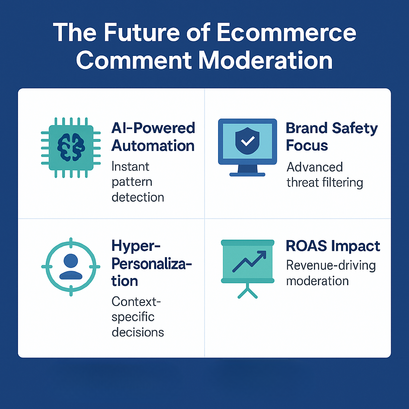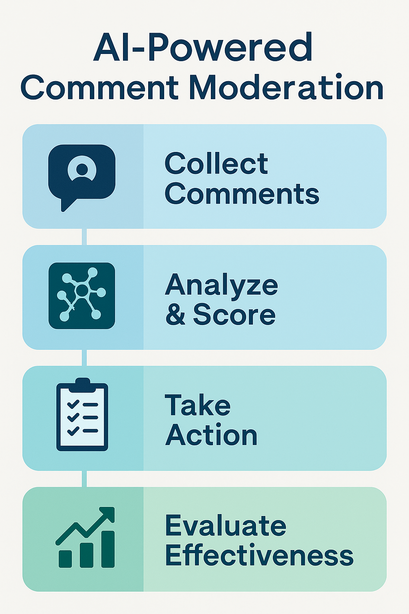December 4, 2025
A data-backed breakdown of the real comment patterns driving ad performance in 2025.
Sep 2, 2025
10 Mins
Discover how ecommerce brands can use customizable social media comment moderation tools to protect ROAS, build trust, and turn engagement into conversions in 2025.

In 2025, ecommerce founders are facing a new reality: your ads and organic social posts are no longer judged by your creative alone—they’re judged by your comment section. From spammy crypto bots to customers asking genuine product questions, every line of text under your ads is shaping trust, conversions, and ultimately, Return on Ad Spend (ROAS).
The challenge? Most brands are still relying on clunky native tools or generic filters that treat every comment as either “positive,” “negative,” or “neutral.” That’s not enough anymore. Nuance matters. A sarcastic remark, a pricing question, or a competitor mention can’t be bucketed so simply.
That’s why content moderation tools have become a must-have for ecommerce. In this guide, we’ll explore the evolution of moderation, why customization is the future, and how brands can protect both their revenue and reputation with smarter strategies.
In the age of performance marketing, comments are no longer just “noise.” They are public testimonials—good or bad—that influence whether a potential buyer clicks buy or keeps scrolling.
When Jobber, a SaaS brand for home services, scaled their Meta ads, they saw thousands of comments flood in—everything from praise to detailed sales questions. Without active moderation, many of those high-value leads went unanswered. (See our audit here).
For ecommerce founders, ignoring comment sections is like ignoring a full inbox of warm leads. Moderation protects your credibility, strengthens community, and creates conversion lift.

Too many CEOs and marketing leads treat comment sections as an afterthought. The assumption is that comments are a social vanity metric, not a revenue lever.
But here’s the reality: unchecked comments can tank ROAS. Negative delivery complaints, “is this a scam?” threads, and competitor spam do more damage than low CTR. And when left unmanaged, they silently eat into performance.
We outlined seven overlooked reasons ads fail to convert in this article. A weak comment strategy is one of them.
In the early stages of ecommerce growth, moderation was often assigned to junior staff or agencies, clicking through comment feeds and manually hiding spam.
Then came Meta’s built-in filters, allowing brands to block certain keywords or auto-hide comments. Helpful, but limited—they can’t handle nuance or intent. (We covered Meta’s limits here).
As AI advanced, tools emerged to classify comments by sentiment. While an improvement, these generic systems often mislabel or overlook context.
Most off-the-shelf content moderation tools categorize comments into three buckets: positive, negative, or neutral. But here’s the problem:
Generic AI can’t make these distinctions. And in ecommerce, those distinctions decide whether you convert a comment into a sale—or lose it.
.png)
This is where Superpower stands apart. Instead of broad sentiment filters, Superpower lets brands create customizable moderation rules:
It’s the difference between a blunt instrument and a precision tool. For founders who care about brand voice and ROAS, customization isn’t optional—it’s the future.
See our full breakdown on boosting ROAS with AI moderation.
Protects ROAS by eliminating spam, competitor promotions, and negative delivery complaints. Directly impacts conversion efficiency and ad performance.
Focuses on building long-term community trust. Brands often assume organic is “anything goes,” but toxic or unanswered comments can still erode credibility.
For practical steps on spam control in ads, see our blog on handling spam comments on Facebook Ads.
Moderation isn’t just about keeping feeds “clean.” It’s about protecting performance marketing investments.
We dug deeper into performance impacts in Why Is My ROAS Dropping? 13 Fixes.
Think of moderation not just as defense, but also as experience design. When a potential customer comments, “Does this come in blue?” and the brand replies within minutes, that’s not moderation—it’s CX.
In 2025, CX-driven brands are treating comment moderation as part of their customer care playbook, not just brand protection. Superpower makes this possible by routing nuanced questions to the right team while still filtering spam.
The best ecommerce brands are now running structured workflows for comment moderation.
(See our Organic Moderation Workflow guide for a deeper dive.)

Every comment is a data point. By connecting moderation with first-party data, brands can:
Moderation tools like Superpower turn raw comment streams into structured insights. Imagine feeding comment questions into your FAQ pages, or repurposing glowing customer replies as UGC in your next campaign.
Regulators are increasingly watching how brands moderate public spaces. Failing to act on hate speech, harassment, or misinformation isn’t just bad PR—it could mean legal exposure.
Founders should ensure their moderation approach is documented, consistent, and transparent. Having customizable rules (vs opaque AI filters) makes compliance easier.
Meta filters and keyword blocks—fine for early-stage brands, but limited.
AI-first platforms like Superpower automate at scale while keeping nuance intact.
Connect moderation with Shopify, Gorgias, or CRM systems to close the loop. (See our post on AI Automation for Shopify).
When choosing a tool, look beyond “does it block spam?” Instead, evaluate:
This checklist separates blunt tools from growth levers.
Ecommerce founders can no longer afford to ignore their comment sections. What once felt like “engagement fluff” is now one of the most powerful levers for performance, brand trust, and CX.
The future of comment moderation belongs to brands that move beyond blunt filters and embrace customizable, nuanced tools. By detecting, filtering, escalating, and responding strategically, you not only protect your ad spend—you turn engagement into growth.
Tools like Superpower exist to help founders make this leap: protecting ROAS, strengthening brand voice, and mining comment threads for insights. The winners of 2025 will be those who see moderation not as a cost center, but as a growth channel.
Q1: What is a content moderation tool for ecommerce?
A software solution that filters, hides, or manages comments on ads and social posts—protecting brands from spam while boosting engagement quality.
Q2: Why do negative comments hurt ROAS?
They lower ad quality signals (raising CPMs) and discourage clicks. See our blog on ROAS drops for more.
Q3: How is Superpower different from other moderation tools?
Unlike generic sentiment filters, Superpower allows custom rules, brand-specific nuance, and integrations with ecommerce stacks.
Q4: Do I need separate tools for organic vs paid comment moderation?
No. Tools like Superpower can handle both, letting you apply different rulesets to each.
Q5: Can moderation really improve conversions?
Yes—by quickly answering buyer questions and removing spam, CTR rises, CPC falls, and ROAS increases.
We’d love your take: How are you currently handling comment moderation—manual, native tools, or AI? Drop your thoughts below and share this guide with another founder who’s scaling ecommerce in 2025.

Explore expert tips, industry trends, and actionable strategies to help you grow, and succeed. Stay informed with our latest updates.